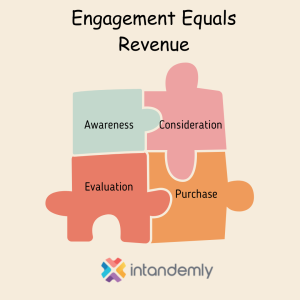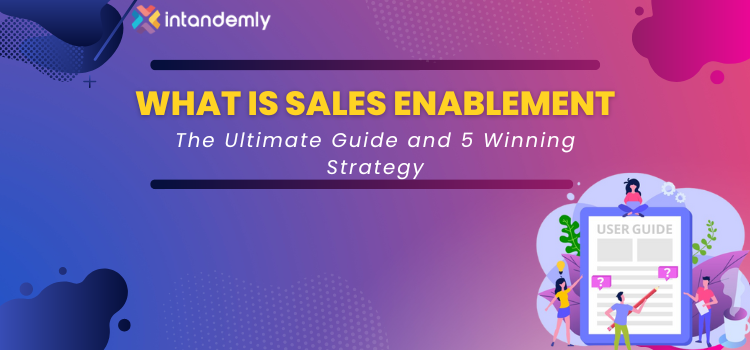What is sales enablement-The Ultimate Guide and 5 Winning Strategy
Introduction
In this comprehensive guide, we delve into the essence of what is sales enablement truly is, exploring its critical components, the myriad benefits it offers, and the strategic pathways to implement it effectively.In the fast-paced world of business, staying competitive requires more than just a quality product or service. It demands a well-orchestrated approach to sales that aligns with the needs and preferences of your customers. This is where sales enablement comes into play. Join us on this journey to demystify the power of sales enablement and its role in driving remarkable business growth.
In order to increase buyer engagement and bolster revenue, sales reps need the right content, training, and materials at their disposal to peak buyers' interest and perform their responsibilities at the highest level. In this guide, you’ll learn the basics of sales enablement strategy as well as best practices, practical examples, and how to build an unstoppable sales team. Consider this your go-to resource as you design and deploy an effective what is sales enablement strategy for your business.
Discover the power of what is sales enablement in our ultimate guide. Learn what sales enablement is and how it empowers your team with tools and knowledge for effective customer engagement, boosting conversions and revenue. Explore key components, benefits, and strategies to implement sales enablement successfully.
What is Sales Enablement
At its core, sales enablement is the strategic approach of providing the sales team with the resources, tools, and information they need to engage prospects effectively throughout the buying journey.It's a comprehensive framework that equips sales professionals with the knowledge, content, and guidance to have meaningful interactions with potential customers, ultimately leading to higher conversion rates and revenue growth.
Key Components of Sales Enablement
- Content Management: One of the fundamental pillars of sales enablement is the creation and management of relevant and valuable content. This includes everything from sales collateral and product guides to customer success stories and competitive analysis. By arming your sales team with these resources, you empower them to address customer pain points and objections more efficiently.
- Training and Development: A well-trained sales force is a powerful asset. Regular training sessions that focus on product knowledge, sales techniques, and market trends keep your team up-to-date and confident. This ensures that they can adapt to changing customer needs and respond effectively to various situations.
- Technology Utilization: Sales enablement tools and technologies streamline various aspects of the sales process. Customer relationship management (CRM) systems, communication platforms, and analytics tools provide insights into customer behavior and preferences, enabling your team to tailor their approach accordingly.
- Collaboration between Sales and Marketing: Sales and marketing alignment is crucial for successful sales enablement. Both teams need to work hand-in-hand to create targeted campaigns, share insights, and ensure a consistent messaging strategy that resonates with potential buyers.
Benefits of Sales Enablement
- Improved Sales Performance: By providing salespeople with the right resources and training, you empower them to close deals more effectively. This leads to higher sales conversion rates and revenue growth.
- Enhanced Customer Experience: A well-informed sales team can offer personalized solutions that cater to the unique needs of each customer. This not only boosts customer satisfaction but also builds long-term relationships.
- Shortened Sales Cycles: Equipped with the right tools, your sales team can navigate the sales cycle more efficiently, addressing customer concerns and objections promptly.
- Increased Cross-Selling and Upselling Opportunities: Sales enablement enables your team to identify opportunities for cross-selling and upselling by understanding the customer's pain points and offering relevant solutions.
- Data-Driven Insights: The use of sales enablement technology provides valuable insights into customer behaviors and preferences, allowing your team to make informed decisions.
3 Defining Principles of Sales Enablement
Principle 1: Commit to a Sales Enablement Process
Establishing a process for what is sales enablement provides the necessary framework to begin coherently organizing, finding, sharing, customizing, and analyzing content. This process requires input from multiple teams, clear expectations, and a plan to execute on sales enablement goals.Establish your sales enablement process with Intandemly today.
Principle 2: Know and Involve Your Sales Team
Think of the sales process as a funnel with four basic stages. The upper half, comprising the “Awareness” and “Consideration” stages, is owned by marketing and is focused on generating interest in the company’s products and services.The lower half is primarily owned by sales and is focused on closing deals and generating revenue. what is sales enablement software is the new key player in transforming this part of the sales cycle and equips sales reps with the tools, skills, and assets they need to effectively engage with buyers and drive maximum revenue for the company.
Principle 3: Engagement Equals Revenue
Sales enablement improves performance by helping reps consistently engage with prospects and customers throughout the buying process.Every salesperson knows that engagement = opportunity. Without strong processes, focus, and intentions, the benefits of sales enablement technologies are inherently limited. By thinking strategically and applying best practices in the critical areas of what is sales enablement content management, sales coaching/training, playbooks, and sales operations, sales enablement can drive astounding results and transform sales effectiveness.

Implementing an Effective Sales Enablement Strategy
- Understand Your Buyer's Journey: To effectively enable your sales team, you must understand your buyer's journey. Identify the stages a prospect goes through, the challenges they face, and the information they need at each step.
- Develop Targeted Content: Create content that addresses the pain points and concerns of your potential customers at different stages of their journey. This can include case studies, whitepapers, videos, and more.
- Provide Ongoing Training: Regular training sessions should cover not only product knowledge but also sales techniques, objection handling, and communication skills.
- Utilize Technology Wisely: Invest in what is sales enablement tools that align with your goals. A CRM system, for instance, can help track customer interactions, while analytics tools provide insights into content effectiveness.
- Encourage Collaboration: Foster collaboration between sales, marketing, and other relevant departments to ensure a unified approach to messaging and customer engagement.
Here are 9 guidelines to follow when crafting your what is sales enablement strategy.
- Evaluate your current marketing and sales process: Identify where there’s opportunity for improvement, where you might be able to expand, or where you can afford to scale back. Document all within a sales enablement charter so that you can have a concrete roadmap to move your company forward.
- Define roles and responsibilities: Once your charter is complete, your next move should be to define the roles and responsibilities for each enablement stakeholder (i.e. leadership, management, and operations).
- Understand your target market: Get to know your ideal customers as you build your sales enablement strategy. This will help lay the groundwork for much of your sales enablement program.
- Map content to the customer journey: After you’ve developed your ideal buyer personas, make sure to outline each profile’s respective buyer journey. These outlines will help with the content management portion of your enablement strategy, empowering you and your team to match existing content (i.e. case studies) to specific consumer stages and their corresponding pain points.
- Get to know your top performers: As you prepare your sales enablement strategy for launch, take some time to really familiarize yourself with your sellers. Observe their day-to-day operations. Meet with reps directly whenever you can. Chat with sales managers and ask for their input on who’s thriving and who’s lagging behind.
- Provide sales onboarding, training programs, and support: Combine everything from customized training paths and templates to comprehensive content recommendations and conversational roleplay. In addition, your strategy should always remain flexible, providing reps with all the intel and materials necessary to stay on top of market trends.
- Establish metrics to measure success: Once your methods of operation start lining up and you’re ready to give your sales enablement strategy the green light, you should round out preparations by: 1. Establishing kpi metrics of success and 2. Identifying parameters for “good” performance.
- Select the right what is sales enablement tool: When evaluating sales enablement tools, be on the lookout for platforms that can streamline communication, have integration with your current stack, automation for tedious tasks, and surface content for sellers at the right time.
- Implement, optimize, repeat: Whatever challenges you face, always be ready to amend your policies and initiatives as needed.
Sales Enablement Best Practices
Here is a quick rundown of the key what is sales enablement and its best practices all teams should know:- Embrace new selling strategies — this means making sales training and onboarding a bigger priority.
- Gain an understanding of what the sales team needs to better address customer questions and pain points.
- Bring marketing and sales together to develop content.
- Create relevant content that combines marketing analytics with reps’ first-hand experience with sales conversations.
- Make technology investments a priority — today’s sales process depends on access to data, automated tasks, and a connected view of every interaction with customers and leads.






![Content Marketing Trends-2024 [Comprehensive Guide]](https://www.intandemly.com/wp-content/uploads/2016/07/content-marketing-blog-banner-50x50.png)

